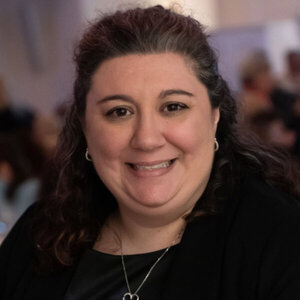Hybrid events can build community online and in real life

“I was taking an online fitness class and someone was talking about how excited she was to attend the gala,” a supporter told me. “I barely know this woman…so imagine how surprised I was when we were seated together at the event! What a lovely opportunity to connect!”
This was just one of the many bonds that were formed or deepened at the Jewish Women’s Foundation of New York’s (JWFNY) 25th Anniversary Kickoff Celebration, both online and in person.
Combined events can be daunting to plan and execute, but they’re worth it. Our event was a rich experience for all, whether virtual or IRL (in real life), replete with interaction, insight, and inspiration. JWFNY recognizes that COVID infections are still a threat, but as the longing for in-person community continues to build, we have transcended the false dichotomy of “in-person or virtual?” Instead of either/or, we are proudly both/and.
Here’s how to make it work:
Don’t discount the lessons COVID-19 taught us. Build on them. In March 2020, as I was planning my first large-scale event at JWFNY, the world began to shut down. With four weeks to go, we made the painful decision to move our gala to Zoom. In 2022, we were as eager as anyone to meet again in person.
We did not, however, rush to the other extreme when, roughly two years after the pandemic started, we reconvened for our 25th Anniversary Kickoff Celebration. Our grantee partners are increasingly spread all over the globe, and like many organizations that pivoted successfully during the pandemic, our donor base is increasingly spread all over the country. Why not use what we’d learned about online events to continue serving those constituents? For example: During the shutdown, we added a monthly program series called Crown JEWEL Conversations to highlight each of our grantee partners. From that series, we reaffirmed that our audience wants to be “up close and personal.” They want to see faces as they talk to one another in the chat. That critical piece of data informed how we planned all of our subsequent online events, and we plan to continue the practice. It’s different from many large-scale live-streamed events, which don’t allow for much interaction.
Two separate but connected events. JWFNY has a reputation for warmth, community, joy, exceptional speakers, and high-level discussion, regardless of the format. In order to continue to provide those elements, we planned two separate, concurrent events. The virtual event had its own program, host, staffing, and conversation spaces. We treated those breakout rooms with the same care and consideration as we did our table seating, stacking each room with a host and a grantee partner, making sure the mix of guests was exactly right. Our virtual guests were encouraged to bring their lunches, and we opened the rooms during lunch to facilitate conversation and build relationships—not just with other donors but also with our grantee partners. By doing so, we deepened everyone’s experience and made the moment more personal. We also gave online participants the opportunity to use the chat to ask questions of the speakers in the ballroom.
You don’t need fancy tech to make it work. When most people think of hybrid events, they think only of the technical side, such as how to livestream, how to make sure the video is accessible, high quality, and meaningful. Often there is a tendency to think that we will have a higher-quality experience if we pay more, and then we start to wonder about whether we should invest in event-specific software. We looked at these options ourselves, because we were determined that our virtual guests would enjoy an experience equal to that of our in-person guests. And then we took a step back and realized that Zoom would be sufficient. It allows for people to interact with one another in breakout rooms as well as watch the program, and it’s a platform our guests already knew how to use.
Allow the good to outweigh the perfect. That said, we used the technology selectively, to our advantage, not just for the sake of it. We were able to livestream from the main camera when we needed to and turn off the camera strategically—no one needed to see everyone in the ballroom eating lunch. And Zoom can be messy: People don’t mute so you hear their dogs barking; inappropriate questions can be put in the chat; technical difficulties like accidentally muting or unmuting can happen. We had at least one camera glitch at the end of the program and a few timing issues. Still, overall the experience was positive for all who attended.
I believe that this model for a hybrid event makes and deepens meaningful connections between donors and the organization and between funders. JWFNY prides itself on being a source of relationships, and our events must continue to deliver that benefit to supporters, however they decide to join us. And to be clear, we have made it happen regardless of the size of the gathering. Our programs, meetings, and events, both large and small, are now all designed to meaningfully include participants from all over the world, including our one-day conference in October, The Convening 2022.
We are proud of the progress we’ve made to incorporate technology into our events and our work. We’ve learned a tremendous amount and are actively working to make each hybrid event better than the last. If we can do this, so can you!
Melissa Rosen is the director of strategic engagement and operations at the Jewish Women’s Foundation of New York.





